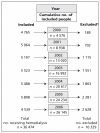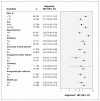Incidence of bleeding from gastroduodenal ulcers in patients with end-stage renal disease receiving hemodialysis
- PMID: 22083684
- PMCID: PMC3255160
- DOI: 10.1503/cmaj.110299
Incidence of bleeding from gastroduodenal ulcers in patients with end-stage renal disease receiving hemodialysis
Abstract
Background: Few large population-based studies have compared the incidence of bleeding of gastroduodenal ulcers between patients with and without end-stage renal disease. We investigated the association between ulcer bleeding and end-stage renal disease in patients receiving hemodialysis, and we sought to identify risk factors for ulcer bleeding.
Methods: We performed a nationwide seven-year population study using data from the National Health Insurance Research Database in Taiwan. We identified 36 474 patients with end-stage renal disease who were receiving hemodialysis, 6320 patients with chronic kidney disease and 36 034 controls matched for age, sex and medication use. We performed log-rank testing to analyze differences in survival time without ulcer bleeding among the three groups. We performed Cox proportional hazard regressions to evaluate the risk factors for ulcer bleeding among the three groups and to identify risk factors in patients receiving hemodialysis.
Results: Patients receiving hemodialysis and those with chronic kidney disease had a significantly higher incidence of ulcer bleeding than controls had (p<0.001). Hemodialysis (hazard ratio [HR] 5.24, 95% confidence interval [CI] 4.67-5.86) and chronic kidney disease (HR 1.95, 95% CI 1.62-2.35) were independently associated with an increased risk of ulcer bleeding. Diabetes mellitus, coronary artery disease, cirrhosis and use of nonsteroidal anti-inflammatory drugs were risk factors for ulcer bleeding in patients with end-stage renal disease who were receiving hemodialysis
Interpretation: Patients with end-stage renal disease who are receiving hemodialysis had a high risk of ulcer bleeding. Diabetes mellitus, coronary artery disease, cirrhosis and the use of nonsteroidal anti-inflammatory drugs were important risk factors for ulcer bleeding in these patients.
Figures



Similar articles
-
Different peptic ulcer bleeding risk in chronic kidney disease and end-stage renal disease patients receiving different dialysis.Dig Dis Sci. 2014 Apr;59(4):807-13. doi: 10.1007/s10620-013-2973-6. Epub 2013 Dec 8. Dig Dis Sci. 2014. PMID: 24318806
-
Nonpeptic ulcer, nonvariceal gastrointestinal bleeding in hemodialysis patients.Am J Med. 2013 Mar;126(3):264.e25-32. doi: 10.1016/j.amjmed.2012.09.010. Am J Med. 2013. PMID: 23410569
-
Peptic ulcer disease risk in chronic kidney disease: ten-year incidence, ulcer location, and ulcerogenic effect of medications.PLoS One. 2014 Feb 3;9(2):e87952. doi: 10.1371/journal.pone.0087952. eCollection 2014. PLoS One. 2014. PMID: 24498412 Free PMC article.
-
[Helicobacter pylori and gastroduodenal pathology in patient with chronic renal insufficiency undergoing dialysis].Nefrologia. 2002;22(4):318-24. Nefrologia. 2002. PMID: 12369122 Review. Spanish. No abstract available.
-
Epidemiological aspects of NSAID gastropathy.Ital J Gastroenterol. 1996 Dec;28 Suppl 4:6-8. Ital J Gastroenterol. 1996. PMID: 9032573 Review.
Cited by
-
Proton-pump inhibitors for prevention of upper gastrointestinal bleeding in patients undergoing dialysis.World J Gastroenterol. 2015 Apr 28;21(16):4919-24. doi: 10.3748/wjg.v21.i16.4919. World J Gastroenterol. 2015. PMID: 25945005 Free PMC article.
-
Hemodialysis Increases the Risk of Lower Gastrointestinal Bleeding and Angiodysplasia Bleeding: A Nationwide Population Study.Gastroenterol Res Pract. 2020 Mar 3;2020:7206171. doi: 10.1155/2020/7206171. eCollection 2020. Gastroenterol Res Pract. 2020. PMID: 32190042 Free PMC article.
-
Development and Validation of a Predictive Risk Algorithm for Bleeding in Individuals on Long-term Hemodialysis: An International Prospective Cohort Study (BLEED-HD).Can J Kidney Health Dis. 2023 Jun 22;10:20543581231169610. doi: 10.1177/20543581231169610. eCollection 2023. Can J Kidney Health Dis. 2023. PMID: 37377481 Free PMC article.
-
Helicobacter pylori: Effect of coexisting diseases and update on treatment regimens.World J Gastrointest Pharmacol Ther. 2015 Nov 6;6(4):127-36. doi: 10.4292/wjgpt.v6.i4.127. World J Gastrointest Pharmacol Ther. 2015. PMID: 26558147 Free PMC article. Review.
-
A comorbidity index for mortality prediction in Chinese patients with ESRD receiving hemodialysis.Clin J Am Soc Nephrol. 2014 Mar;9(3):513-9. doi: 10.2215/CJN.03100313. Epub 2013 Dec 5. Clin J Am Soc Nephrol. 2014. PMID: 24311712 Free PMC article.
References
-
- US Renal Data System USRDS 2007 annual data report: atlas of chronic kidney disease and end-stage renal disease in the United States. Bethesda (MD): National Institutes of Health, National Institutes of Diabetes and Digestive and Kidney Diseases; 2007
-
- Department of Health National health insurance annual statistical report. Taiwan: Department of Health; 2004
-
- Margolis DM, Saylor JL, Geisse G, et al. Upper gastro-intestinal disease in chronic renal failure. Arch Intern Med 1978;138:1214–7 - PubMed
-
- Musola R, Franzin G, Mora R, et al. Prevalence of gastro-duodenal lesions in uremic patients undergoing dialysis and after renal transplantation. Gastrointest Endosc 1984;30:343–6 - PubMed
-
- Kang JY, Wu AY, Sutherland IH, et al. Prevalence of peptic ulcer in patients undergoing maintenance hemodialysis. Dig Dis Sci 1988;33:774–8 - PubMed
Publication types
MeSH terms
LinkOut - more resources
Full Text Sources
Medical
